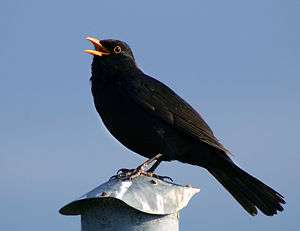Thai Elephant Orchestra
The Thai Elephant Orchestra is a musical ensemble consisting of as many as fourteen Thai elephants near Lampang in Northern Thailand. The elephants play music, essentially as conducted improvisations, on specially designed heavy-duty musical instruments. The orchestra was co-created by elephant conservationist Richard Lair of the National Elephant Institute and the American musical artist and neuroscientist Dave Soldier. They have released three CDs on the Mulatta Records label with an orchestra ranging in size from six to fourteen elephants. The orchestra currently performs for visitors at the center.
Background
It has been noted since ancient times that elephants seem to have an affinity for music. Performing circus elephants commonly follow musical cues, and early American circuses such as Adam Forepaugh and Barnum & Bailey even featured "elephant bands."[1] In the 1950s, German evolutionary biologist Bernard Rensch found that elephants can distinguish 12 tones on the musical scale and remember simple melodies, even when played on different instruments at various pitches, timbres, and meters.[1][2]
Three albums of music created by elephant musicians was conceived by New York-based musical artist Dave Soldier (a.k.a. David Sulzer, PhD) and elephant expert Richard Lair, who works at the Thai Elephant Conservation Center in Lampang. Traditional Thai music is a genre familiar to the elephants, so they chose Thai music scales with a few blues notes. According to Lair, many of the elephants took to their assignment "with gusto".[3]
Music
The Thai Elephant Orchestra primarily uses the Lanna Thai five-note scale, and most instruments are heavy-duty versions of traditional Thai musical instruments; additional instruments include drums and harmonica.[4]
Their musical works are of two general types. The first type features the elephants individually improvising on the instruments with the only human interaction being cues as to when to start and stop. The other type is compositional and requires mahouts to teach or train the elephants to perform human tunes as a hocket, with each elephant playing an individual note on tuned instruments such as angalungs.[5]
- Discography
- (2002) – The Thai Elephant Orchestra
- (2005) – Elephonic Rhapsodies
- (2011) – Water Music
References
- Scigliano, Eric (December 16, 2000). "Think Tank; A Band With a Lot More to Offer Than Talented Trumpeters". New York Times. Arts.
- Flores, Graciela (June 1, 2007). "When I see an elephant...paint?". The Scientist. Retrieved 21 March 2013.
- "Elephant Band : Transcript". PRI : Living on Earth. Air Date: Week of March 2, 2001: World Media Foundation. Retrieved 28 March 2013.CS1 maint: location (link)
- Soldier, Dave (2002). "Eine Kleine Naughtmusik: How Nefarious Nonartists Cleverly Imitate Music" (PDF). Leonardo Music Journal. 12: 57–58. doi:10.1162/096112102762295142. Retrieved 25 March 2013.
- "Thai Elephants on Parade". WNYC. New Sounds : Episode #2329: New York Public Radio. October 12, 2004. Archived from the original on 28 July 2012. Retrieved 28 March 2013.CS1 maint: location (link)
External links
- "Thai Elephant Orchestra". Art & Culture. Thai Elephant Conservation Center. Archived from the original on 2012-09-04.CS1 maint: BOT: original-url status unknown (link) — Story, photos and 4-part documentary
- The Thai Elephant Orchestra at Mulatta Records (includes audio samples)
- Kinship with Animals : Thai Elephant Orchestra , article by Dave Soldier
- Video documentary on the Thai Elephant Orchestra by Paul Spurrier
- "Audio: Elephant Orchestra". Thai Elephants. National Geographic Society. — Includes 3 songs
- 2013 Interview with Dave Soldier on Thai Elephant Orchestra on BBC
- 2013 Interview about The Thai Elephant Orchestra, NPR: All Things Considered by Jacki Lyden
- Story from BBC
- Interview on WNYC Radio by John Schaefer
- The Thai Elephant Orchestra in The Economist
- National Geographic on the Thai Elephant Orchestra
- Swedish TV episode on the Thai Elephant Orchestra (in Swedish)
- Mother Jones on the Thai Elephant Orchestra
